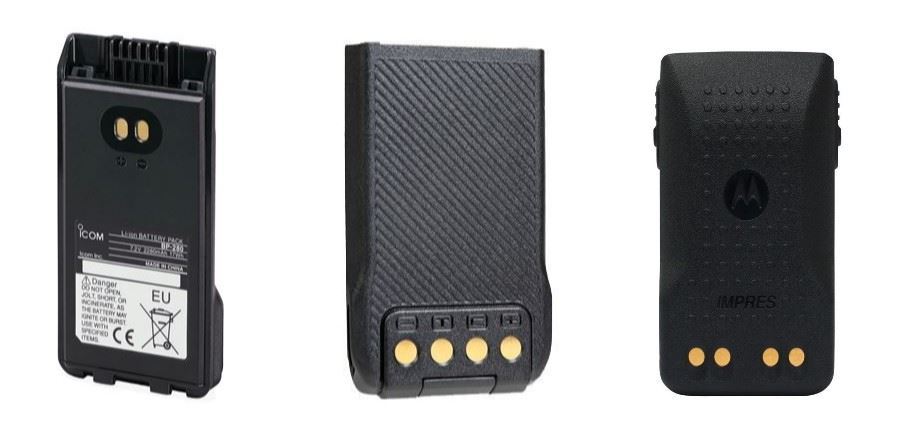VHF or UHF Two-Way Radio? Which is Best For You?
 23rd Aug 2022
23rd Aug 2022

 Released On 7th Sep 2022
Released On 7th Sep 2022
Our guide to NiMH vs Lithium-ion batteries answers your questions about longevity, power, battery charging cycles, self-discharge, memory effect and much more.
For many years, right up to the early 1990s, most portable devices were powered by nickel cadmium (NiCad) batteries. While NiCad batteries were cheap and easy to recharge, they weren't especially powerful and they contained toxic substances that are bad for the environment.
NiMH and Lithium-ion (Li-Ion) batteries have now largely replaced Ni-Cad batteries, dominating the battery market for two-way radios.
As a major battery supplier for many years, our experience in this area will help to dispel any confusion as you shop our site for your two-way radio batteries.
A: NiMH stands for Nickel Metal Hydride. Nickel is a dense metal related to iron.
A: Li-Ion means Lithium Ion. Lithium is a lighter metal – in fact, it’s the lightest metal there is.
A: Size, weight, power output and memory effect are the biggest differences:
For a battery of each type with the same storage capacity, a NiMH battery will be smaller, but much heavier, than a Li-Ion battery (the weight difference can be approximately 20% - 35%). For most two-way radio users, especially for handheld two-way radios that you carry around with you, weight is more important than size.
Each NiMH battery cell can deliver about 1.2V of power, putting them at a disadvantage to lithium-ion batteries, which have one of the highest energy densities of any modern battery type, delivering around three times the output, or 3.6V per cell.
NiMH batteries also suffer much more than Li-Ion batteries from "memory effect", which can diminish a battery's capacity to hold a full charge over time. We describe memory effect more fully below.
A: NiMH batteries suffer quite badly from something called “memory effect”. What this means is that if you frequently recharge a battery while it’s only partially discharged, the battery will effectively "memorise" the decreased life cycle, losing its original capacity for a full charge. The shortened usage time of a radio between charges could create problems for a business, for example where users are working long shifts.
Li-Ion batteries, however, suffer from hardly any memory effect – there’s no need to wait for the battery to completely discharge; you can recharge it any time you want with very little effect on its future charge capacity.
(One small caveat to this is that it’s a good idea to fully charge a brand new Li-Ion battery before first use, and it’s a good idea to let it discharge completely from time to time - battery experts recommend this after every 30 charges.)
A: Self-discharge is the gradual loss of battery charge over time, either because it is not being used, or owing to environmental conditions such as heat or cold.
On average, NiMH batteries self-discharge at a rate of between 5% and 20% on the first day, and up to 4% per day thereafter at room temperature , but at 45°C, the discharge rate can be three times that.
By contrast, Li-ion batteries self-discharge at a rate of around 5% on the first day, and then approximately 1.5% to 2% per month. Again, this is greatly affected by heat and cold; extremes of either will increase the self-discharge rate. Scientists are working hard to improve battery endurance at lower temperatures, so we can expect to see this reflected in real-world self-discharge rates in the future.
A: Opinions differ a little but generally, lithium-ion rechargeable batteries have greater longevity than NiMh batteries, at around 700 to 950 charge cycles compared to between 500 to 800 charge cycles for NiMH batteries.
A: Li-Ion batteries were expensive to manufacture when the technology was new, but prices have come down since then. They may still be a little more expensive than NiMH batteries owing to the advantages they provide over other types of battery.
A: Stories abounded in the early years of Li-ion batteries about them bursting into flame. It’s true that there was a problem with the chemistry in the batteries back then – if the battery was accidentally over-charged there was a chance it could overheat and set itself on fire. But in 1996 the chemical formula was changed; Lithium-Cobalt-Oxide was replaced by the much safer Lithium Iron Phosphate, a formula with very low combustibility. It's probably still a good idea not to leave your two way radio charging indefinitely though. Remove it from the charger as soon as possible after it's fully charged.
A: mAh stands for milli Amp hour and is a measure of a battery's energy storage capacity. The greater the battery's mAh, the more power it can hold. An mAh rating can be used to compare the energy capacity between batteries of the same type such as two NiMH batteries.
If you need help choosing the right battery for your two-way radio, please contact us for assistance.
 23rd Aug 2022
23rd Aug 2022
 13th Jan 2022
13th Jan 2022
Stay up to date with the lastest from RadioTrader